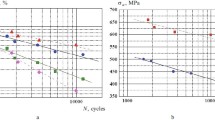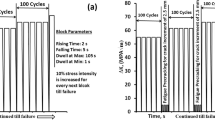Abstract
Fatigue tests by axial loading (R-0.05) were carried out to investigate short fatigue crack growth behavior in 2 1/4 Cr-1 Mo steel at room temperature using smooth and a small notched flat specimen. All the data of the fatigue crack growth rate in the present tests were analyzed as a function of the stress intensity factor equation in conjunction with crack closure behavior. Analysis was performed accounting for the relation of surface effective stress range,Ua and depth effective stress range,Ub. In the case of isotropic crack growth properties,Ub=(ΔKta/ΔKtb) ·Ua. By use ofUb obtained from the analysis, crack growth rates to surface direction coincide with those of depth direction.
Similar content being viewed by others
References
De Los Rios, E.R., Tang, Z. and Miller, K.J., 1984, “Short Crack Fatigue Behavior in a Medium Carbon Steel”, Fatigue Fract. Engng. Mater. Struct. Vol. 7, pp. 97–108.
Elber, W., 1971, “The Significance of Fatigue Crack Closure”, ASTM STP 486, pp. 230–242.
El Haddad, M.H., Smith, K.N. and Topper, T.H., 1979, “Fatigue Crack Propagation of Short Cracks”, Trans. of ASME, J. of Engng. Mater. and Technology, No. 101, pp. 42–47.
Gangloff, R.P., 1981, “Quantitative Measurements of the Growth Kinetics of Small Fatigue Cracks in 10Ni Steel”, ASTM STP 738, pp. 120–138.
Hudak, S.J. Jr., 1981, “Small Crack Behavior and the Prediction of Fatigue Life”, J. of Eng. Materials and Technology, No. 103, pp. 26–35.
Hudak, S.J. Jr. and Chan, K.S., 1986, “In Search of a Driving Force to Charactering the Kinetics”, Proc. of the 2nd Eng. Foundation Int. Conf. CA, pp. 379–405.
Iyyer, N.S. and Dowling, N.E., 1986, “Opening and Closing of Cracks at High Cyclic Strains”, Proc. of the 2nd Eng. Foundation Int. Conf. CA, pp. 213–223.
Jolles M. and Tortoriello V., 1983, “Geometry Variations During Fatigue Growth of Surface Flaws”, ASTM STP 791, pp..
Jono, M. and Song, J., 1985, “Growth and Closure of Short Fatigue Cracks”, Material Research series, Vol. 1, pp. 35–55.
Kitagawa, H., Takahashi, S., Suh, C.M. and Miyashita S., 1979, “Quantitative Analysis of Fatigue Process-Microcracks and Slip Lines under Cyclic Strains”, ASTM STP 675, pp. 420–449.
Kitagawa, H., Yuuki, R. and Suh, C.M., 1980, “Growth Behaviors of Fatigue Surface Crack initiated at a Small Artificial Notch”, Preprint of Soc. of Mater. Science Japan, pp. 26–30.
Leis, B.N., 1985, “Displacement Controlled Fatigue Crack Growh in Inelastic Notch Fields: Implications for Short Cracks”, Engineering Frac. Mechanics, Vol. 22-2, pp. 279–293.
Paris, P.C. and Erdogan F., 1963, “A Critical Analysis of Crack Propagation Law”, ASME J. of Basic Eng. 85, pp. 528–538.
Raju, I.S. and Newman, J.C. Jr., 1979, “Stress Intensity Factors for a Wide Range of Semi-elliptical Surface Cracks in Finite-Thickness Plates”, Engineering Fracture Mechanics, Vol. 11–4, pp. 817–829.
Newman, J.C. Jr., and Raju, I.S., 1983, “Stress Intensity Factor Equations for Cracks in Three-Dimensional Finite Bodies”, ASTM STP 791,.
Newmann, J.C. Jr., and Raju, I.S., 1981, “An Empirical Stress Intensity Factor Equation for the Surface Crack”, Engineering Fracture Mechanics, Vol. 15-1, pp. 185–192.
Ritchie, R.O. and Yu, W., 1986, “Short Crack Effects in Fatigue: A Consequence of Crack Tip Shielding”, Proc. of the 2nd Eng. Foundation Int. Conf. CA, pp. 167–189.
Skelton, R.P., 1982, “Growth of Short Cracks During High Strain Fatigue and Thermal Cycling”, ASTM STP 770, pp 337–381.
Staal, H.U. and Elen, J.D., 1979, “Crack Closure and Influence of Cycle Ratio R on Fatigue Crack Growth in Type 304 Stainless Steel at Room Temperature”, Eng. Fracture Mechanics, Vol. 11, pp. 275–283.
Suh, C.M. and Kim, G.N., 1984, “A Study on the Initiation and Growth Behaviors of Surface Crack in Type 304 Stainless Steel at Room Temperature”, Trans. of KSME, Vol. 8, pp. 195–200.
Suh, C.M. and Kitagawa, H., 1987, “Crack Growth Behaviour of Fatigue Microcracks in Low Carbon Steels”, Fatigue Fract. Engng. Mater, Struct. Vol. 9, pp. 409–424.
Suh, C.M., Kwon, O.H. and Lee, J.J., 1987, “Crack Growth Behavior of Fatigue Surface Crack Initiated from a Small Surface Defect”, Trans. of KSME, Vol. 11, pp. 191–197.
Suresh, S., Zamiski, G.F. and Ritchie, R.O., 1982, “Fatigue Crack Propagation Beavior of 2 1/4 Cr-1 Mo Steels for Thick-Wall Pressure Vessels”, ASTM STP 755, pp. 49–67.
Author information
Authors and Affiliations
Rights and permissions
About this article
Cite this article
Suh, C.M., Ritchie, R.O. & Kang, Y.G. Growth behavior of short surface fatigue cracks in 2 1/4 Cr-1 Mo steel. KSME Journal 3, 78–85 (1989). https://doi.org/10.1007/BF02953592
Received:
Issue Date:
DOI: https://doi.org/10.1007/BF02953592




